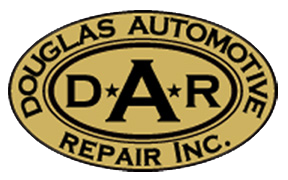Among all the equipment in your vehicle, belts and hoses have the shortest life span. Due to constant exposure to heat, vibration, and harmful chemicals, these components invariably crack, leak, fray and peel. If not promptly replaced and maintained, this could spell disaster for the performance of your vehicle. Evaluating the condition of your belts and hoses only on their appearance is not enough. Periodic inspection is required, and Douglas Automotive Repair Inc is here to do it. Here’s a sample of how we ensure belt and hose quality:

Visual Inspection of Belts:
- Inspect for damage (cracking, glazing, softening, or peeling)
- Check for correct tension
- Check for correct alignment
Visual Inspection of Hoses
- Inspect for damage (leaks, cracks, hardening, or softening)
- Pressure test cooling system for leaks
It’s vital to inspect your vehicle’s belts and hoses on a regular basis because often times a damaged piece has serious effects on the condition of your vehicle. Following is a brief description of some of the different belts and hoses we inspect.
Drive Belts: The engine itself is used as a power source to drive some of your vehicle’s accessories. Instead of being supplied by electric power, these accessories rely on a series of pulleys and belts to operate. Some of these accessories include:
- Power steering pump
- Alternator
- Air conditioning compressor
- Radiator cooling fan
- Water pump
(Most newer vehicles require a single serpentine belt to power these accessories as opposed to several individual belts.)
Hoses: If you think of hoses as your vehicle’s circulatory system, then you’ll have an appropriate representation of how important they are. Channeling car fluids to their correct destination, hoses are composed of two rubber layers with fabric in between. Types of hoses vary on make and model, but typically they include:
- Fuel hose (sends gasoline from gas tank to the engine)
- Radiator hose (delivers coolant to engine)
- Power steering hose (connects power steering pump to steering equipment
- Heater hose (provides coolant to heater core)
Why is it important to replace my vehicle’s belts & hoses? Replacing belts and hoses at the first sign of wear helps avoid unexpected breakdowns and the engine damage that overheating can cause.
How do I know when it’s time to replace my belts and/or hoses? Signs that you should have your belts checked include:
- Cracks in the belt material
- Splitting, peeling or fraying belts
You should have your hoses checked if you notice any of the following:
- Bulging or inflated hoses
- Hardened or inflexible hose material
- Cracks along the hose
- Worn or corroded hose clamps
Call Douglas Automotive Repair Inc today or use our convenient on-line request form on our website to schedule your belt and hose inspection.
This entry was posted in Belts, Hoses, Preventive Maintenance, Vehicle Inspection, Vehicle Maintenance
